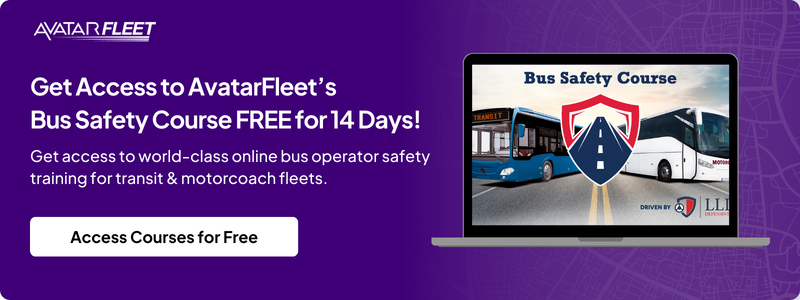Training your bus operators costs you thousands of dollars per trainee. You probably want to know if what you’re doing is worthwhile.
An effective training program is the difference between saving and losing millions of dollars in cost of loss. It’s the difference between growing as a business and struggling through poor results. More importantly, it could be the difference between lives saved and lives lost.
We’ll dive into how you can gauge the success of your bus operator training program. We’ll also explain what to do if you don’t like your results.
How to Track Your Results

It’s crucial to track your bus operator training results. If you don’t, you won’t know you have an issue until it’s too late.
There are three steps you need to take to determine if your bus operator training is working:
- Track your Key Performance Indicators
- Start with the end in mind
- Compare your results
Keeping all of the above in mind is the first step.
Track Your KPIs

Key Performance Indicators (or KPI for short) are the metrics that are important to your success as a company. They’re different from industry to industry, and they even vary from company to company within an industry.
For you as a bussing operation, important KPI could be:
- Number of customer complaints
- Number of delays
- Average trip time
- Accident frequency
- Cost per accident
- Number of vehicle breakdowns
However, there is one KPI that is absolutely essential to track: loss leading indicators.
Loss leading indicators are metrics that predict accident frequencies. Most companies are familiar with the opposite of these, lagging indicators. A lagging indicator is the accident, but the loss leading indicator is the unsafe behavior or condition that caused the accident.
A common lagging indicator for you might be rear-end collisions. This is important to track, but it only tells you so much. You also need to track the frequency of loss leading indicators such as:
- Hard braking events
- Failure to maintain a safe following distance
- Texting and driving
When you see these events increase, you can predict you’ll soon see rear-end collisions. This allows you to be proactive.
You’ll need to invest in mix-telematics such as event video recorders in order to track this data. However, it’s well worth the cost. Once you’re able to see the frequency of various loss leading indicators, you’ll be able to tailor your training program to reduce those events and see if what you’re doing is working.
As the old saying goes, you can’t change what you don’t measure.
Start With The End in Mind
We’re stealing this concept from Stephen Covey, author of “7 Habits of Highly Effective People.” Starting with the end in mind applies to a training program just as well as it does to leadership principles.
When you’re launching your bus operator training program, make sure you know what you want to accomplish. This goes back to the loss leading indicators.
If you have a list of ten loss leading indicators that are causing your most common and costly accidents, make sure you invest in a safety training program that will address those accidents. Invest time in training to prevent rear-end collisions, rollovers, distracted driving events, sideswipes, fixed object collisions, and whatever else is happening.
Our online safety program The Bus Safety Course tackles the most common and costly accidents that plague bussing operations all across the country. We developed it from our 30+ years of experience creating custom curriculum for industry leaders.
If you want to see at least a 20% reduction in accident frequency, try out The Bus Safety Course for free.
Check Your Results
Putting in the work to identify your important KPI, build your training around them, and track your results won’t do you any good if you don’t analyze the data.
Once per month, or more frequently depending on your training cycles, you need to investigate your accident data. Compare and contrast from month to month and year to year. Look for trends such as:
- KPIs rising or falling
- Specific drivers or locations having issues
- Times of year or driving environments that cause issues
You should see your KPI consistently improving. If you don’t, something isn’t working.
Our clients using The Bus Safety Course have an easier time tracking this data. The Bus Safety Course comes with access to a learning management system. This would allow you to enroll your operators in courses, track their results, and save reports on training.
You’ll always know which operators have taken what training.
What if You Don’t Like What You See?
Don’t panic if what you’re doing isn’t working. If you care to track and analyze your training data, you’re already better off than half the transportation companies in America.
However, you won’t see different results if you don’t do something different. You need to change.
The best place to start is deciding what your KPIs are and figuring out a way to track them. The second step is to implement a training program that will cover those KPI’s.
If you don’t want to start at the ground floor, consider subscribing to The Bus Safety Course. You’ll have access to world-class training at an affordable rate.
Sign up for our newsletter
Get the latest articles on all things transportation delivered straight to your inbox.
Schedule a live demo

